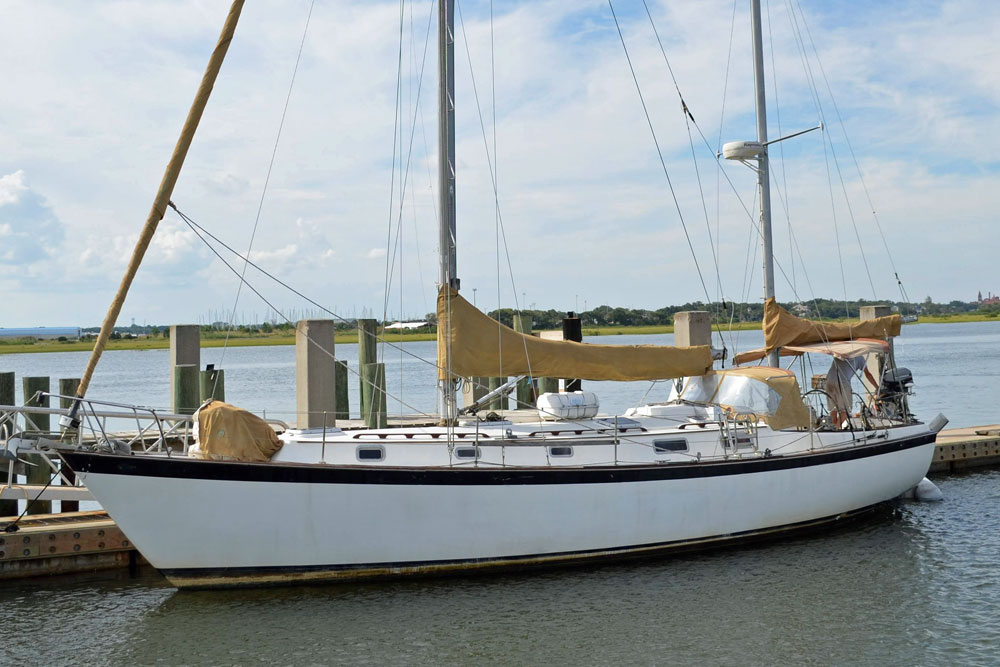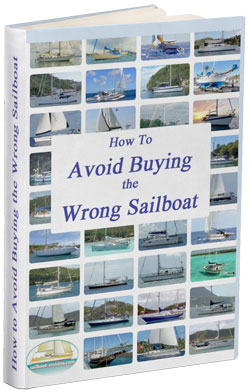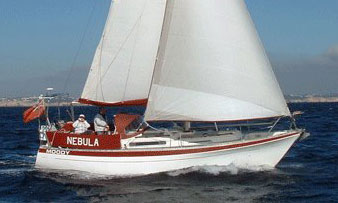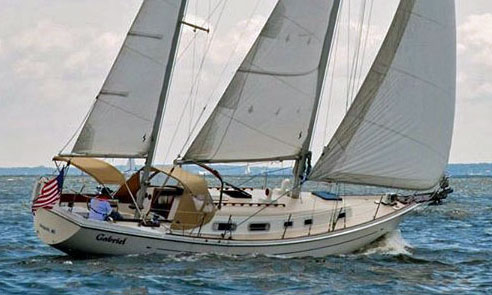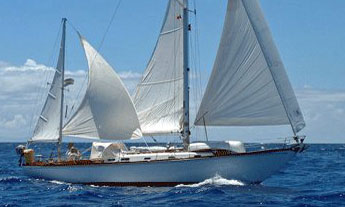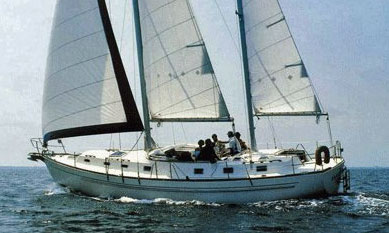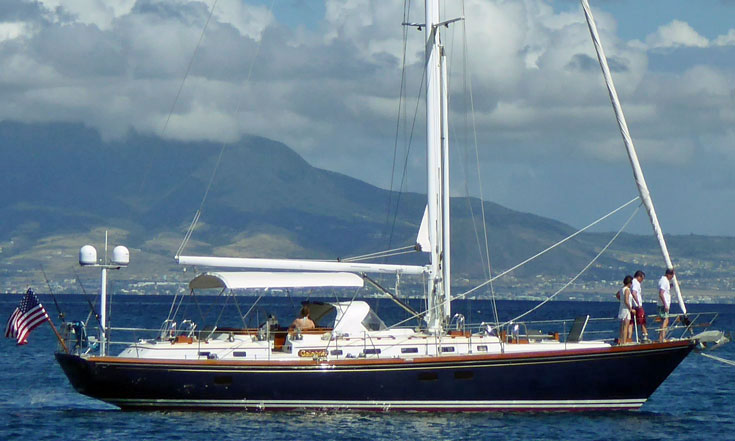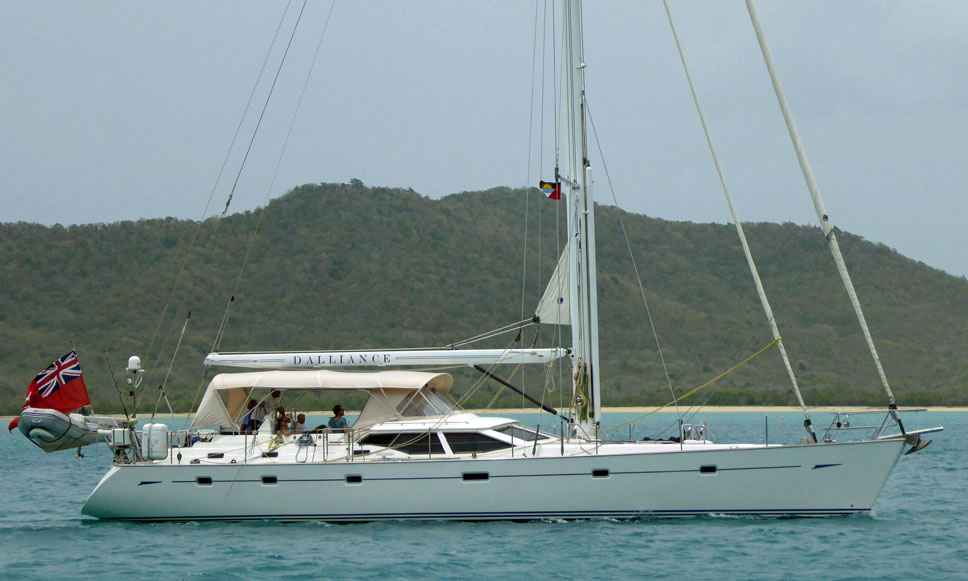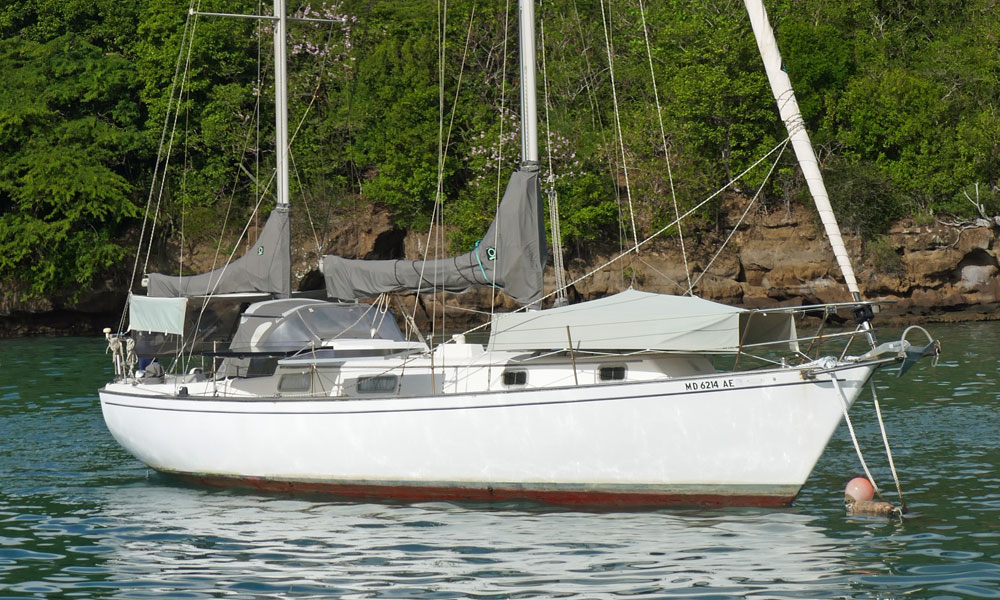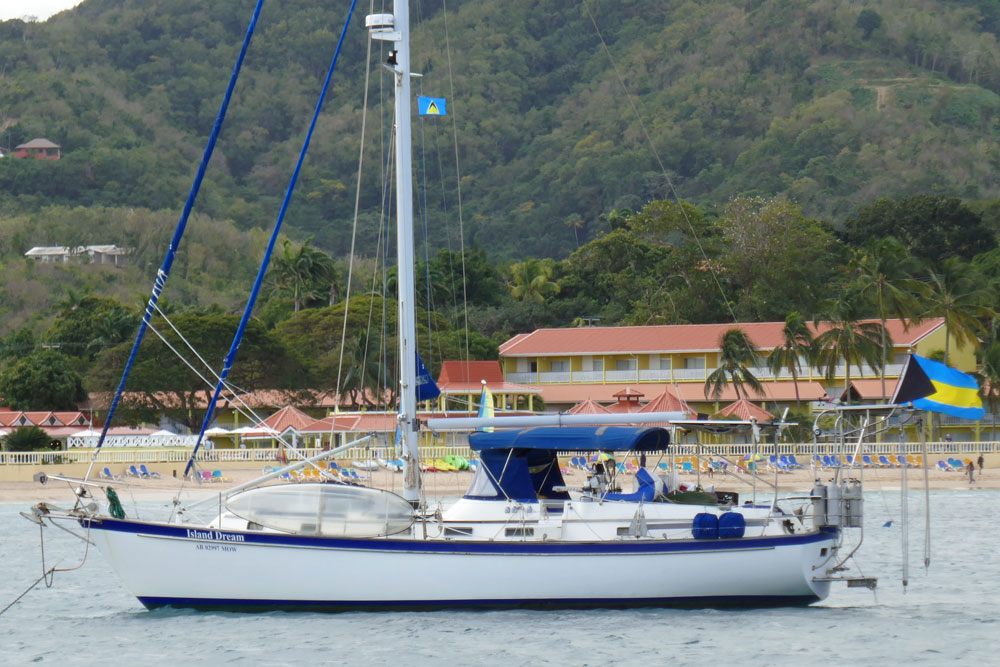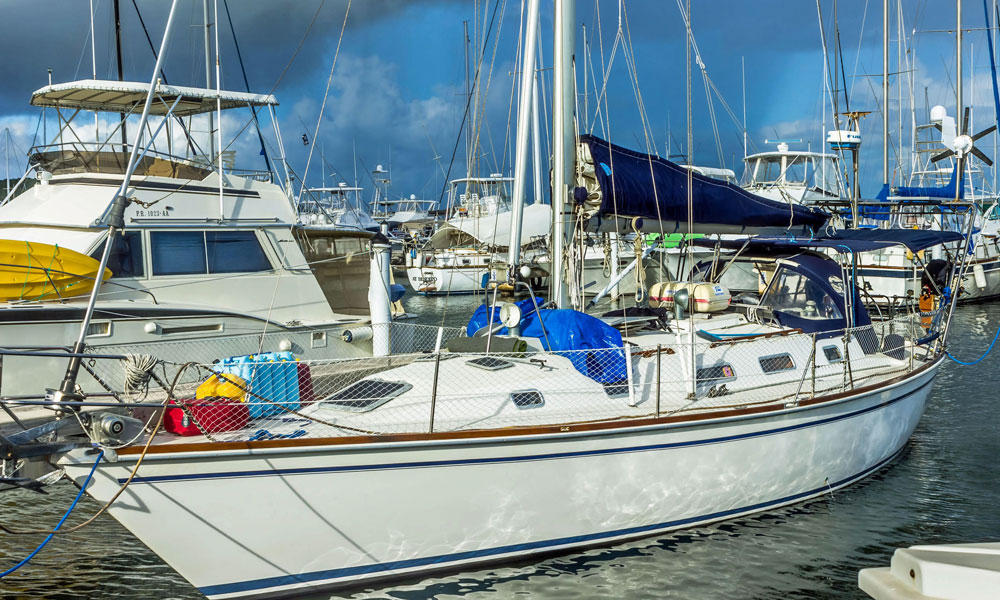- Home
- Cruising Yachts 40' to 45'
- Pearson 424
The Pearson 424 Sailboat
Specs & Key Performance Indicators
The Pearson 424 sailboat was designed by William Shaw and manufactured by Pearson Yachts in the United States throughout the years 1978 to 1983.
Published Specification for the Pearson 424
Keel & Rudder Configuration: Fin keel and skeg rudder
Hull Material: Fibreglass (GRP)
Length Overall*: 12.90m (42'4")
Waterline Length*: 10.49m (34'5")
Beam*: 4.09m (13'5")
Draft*: 1.83m (6'0")
Rig Type: Ketch
Displacement*: 9,525 kg (21,000 lbs)
Ballast*: 4,082 kg (9,000 lbs)
Sail Area*: 78.5m2 (845ft2)
Water Tank Capacity: 795 litres (210 US gallons)
Fuel Tank Capacity: 473 litres (125 US gallons)
Hull Speed: 7.6 knots
Designer: William Shaw
Builder: Pearson Yachts
Year First Built: 1978
Year Last Built: 1983
Number Built: 227
* Used to derive the design ratios referred to later in this article - here's how they're calculated...
Options & Alternatives
Rig type: The standard rig for the Pearson 424 was a ketch. However, a sloop rig option was also available for buyers.
Interior layouts: The Pearson 424 was offered with at least two main interior layouts:
- A two-stateroom version with a large owner's cabin aft.
- A three-stateroom version, often achieved by converting the workshop/storage area into an additional cabin.
Sail Areas & Rig Dimensions
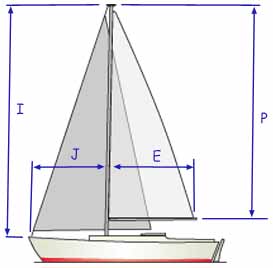 Sail Areas & Rig Dimensions
Sail Areas & Rig DimensionsSail Areas (for ketch)
- Mainsail Area: 35.8m2 (385ft2)
- 100% Foretriangle Area: 42.7m2 (460ft2)
- Mizzen Sail Area: 11.2m2 (120ft2)
Rig Dimensions
- I (foretriangle height): 17.53m (57'6")
- J (foretriangle base): 4.97m (16'4")
- P (main luff): 15.39m (50'6")
- E (main foot): 4.67m (15'4")
Published Design Ratios
The Key Performance Indicators (KPIs)
The key design ratios for the Pearson 424 are:
- Sail Area/Displacement (SA/D): 16.51
- Displacement/Length (D/L): 287.97
- Ballast/Displacement Ratio (B/D): 42.85%
- Capsize Screening Formula (CSF): 2.01
- Motion Comfort Ratio (MCR): 36.87
Theoretical Sailing Characteristics
These design ratios offer insights into the Pearson 424's theoretical sailing performance:
- The Sail Area/Displacement (SA/D) ratio of 16.51 indicates a moderate performance cruiser. This suggests the Pearson 424 is adequately powered to move well in light to moderate winds without being overly tender in stronger breezes. It balances performance with stability, making it suitable for general cruising rather than racing.
- A Displacement/Length (D/L) ratio of 287.97 places the Pearson 424 in the heavy cruiser category. This implies a comfortable motion in a seaway, as heavy boats tend to cut through waves rather than bouncing over them. It also suggests excellent load-carrying capacity for provisions and gear, which is highly desirable for extended voyages. While comfortable, its heavy displacement means it won't be the fastest boat, particularly in light air, but it will maintain momentum well.
- The Ballast/Displacement Ratio (B/D) of 42.85% is quite robust. This high percentage indicates a stiff and stable vessel that will resist heeling significantly in a breeze and recover quickly from heeling. This is a crucial factor for crew comfort and safety, especially when sailing in challenging offshore conditions.
- The Capsize Screening Formula (CSF) of 2.01 is excellent for offshore sailing. A value of 2.0 or less is generally considered very safe, indicating a low risk of capsize in rough seas. This ratio underscores the Pearson 424's suitability as a seaworthy offshore cruising platform.
- Finally, the Motion Comfort Ratio (MCR) of 36.87 is quite high, reinforcing the expectation of a very comfortable ride in various sea states. This factor, combined with its heavy displacement, makes the Pearson 424 a desirable choice for those prioritizing comfort during long passages.
In essence, the design ratios paint a picture of the Pearson 424 as a stable, stiff, comfortable, and seaworthy heavy displacement cruising yacht with respectable but not exhilarating sailing performance. It is clearly designed for comfortable passage making and long-term liveaboard cruising, with an emphasis on safety and stability.
But the Design Ratios are Not the Whole Story...
While design ratios provide a helpful starting point, they are significant simplifications and have limitations when fully defining a sailboat's characteristics:
- Oversimplification of Hull and Keel Design: Ratios cannot convey the nuances of a boat's hull shape, the specific foil sections of its keel and rudder, or how these elements interact with water flow. Two boats with identical ratios could sail very differently due to subtle design variations below the waterline.
- Dynamic Performance Isn't Captured: Ratios are static numbers. They don't predict how a boat will perform dynamically – how it points into the wind, accelerates, handles waves, or performs off the wind. These aspects depend on complex hydrodynamic interactions that ratios don't illustrate.
- Ignorance of Build Quality and Rigging: The quality of construction, stiffness of the overall structure, and efficiency of the rigging system (e.g., mast flex, sail shape control) are not accounted for by simple ratios, yet they profoundly impact a boat's real-world performance and feel.
- Crew Skill and Sail Inventory: A boat's actual performance is heavily influenced by the skill of its crew in sail trim and helming, as well as the quality and range of sails available. These human and equipment factors are entirely outside the scope of design ratios.
- Specific Design Intent is Lost: Ratios won't tell you if a boat was specifically designed for light air, heavy weather, racing, or cruising. A designer's specific optimizations are often hidden within the detailed lines and features, not just the broad measurements.
- Subjectivity of "Comfort": While the Motion Comfort Ratio aims to quantify comfort, individual tolerance for motion at sea varies widely. What one person finds comfortable, another might not.
- Relevance to Modern Designs: Ratios were primarily developed for traditional displacement hulls. Modern designs, including those with wider sterns, lighter displacements, or planing capabilities, can exhibit ratios that seem unconventional but perform exceptionally well due to advanced design principles not captured by these simple formulas.
In conclusion, while design ratios offer useful initial insights for comparing boats, they serve as a starting point, not a complete picture. A comprehensive understanding of a sailboat's characteristics requires delving into specific design details, construction methods, and, most importantly, actual experience sailing the vessel in varied conditions.
More Specs & Key Performance Indicators for Popular Cruising Boats
.........................
I used GPT-4, OpenAI’s large-scale language-generation model, as a research assistant to gather information, summarize research findings, and provide suggestions for the content and structure of this article.
Dick McClary, creator and owner of sailboat-cruising.com
.........................
Other sailboats in the Pearson range include:
Recent Articles
-
Passoa 47 Sailboat Review: Comprehensive Specs & Performance Analysis
Jan 04, 26 04:57 AM
Discover the Passoa 47, a legendary aluminium blue water cruiser by Garcia. Explore technical specifications, design ratios, and why its lifting keel is a game-changer for offshore sailors. -
Sailboat Wheel Steering Maintenance & Inspection Checklist
Dec 30, 25 02:32 PM
Keep your vessel’s helm responsive and reliable with our expert maintenance checklist. Master cable tensioning and system inspections to avoid mid-passage failures. -
Modern Boat Electronics and the Latest Marine Instruments
Dec 20, 25 05:27 PM
Should sailboat instruments be linked to the latest boat electronics as a fully integrated system, or is it best to leave them as independent units?
